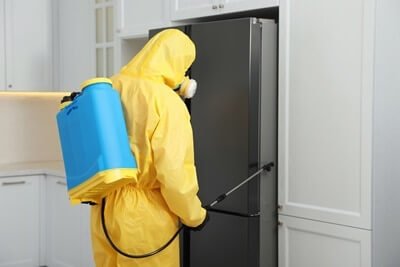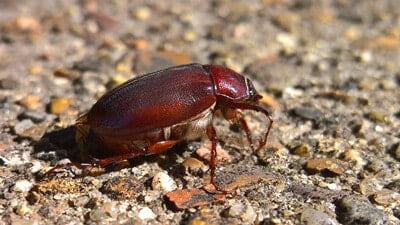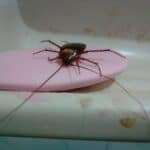Nobody wants to find cockroaches inside their refrigerator. These pests can spread bacteria and mold spores across your food. Thankfully, there are ways to clear out cockroaches from your fridge.
Cockroaches can get inside a fridge by slipping between gaps in the door. If the rubber seal is loose, they’ll find an entry point. They can also sneak in through cracks or crevices in the outer shell. If the back or underside components leave an opening, cockroaches can use this to reach the interior.
Once inside, cockroaches can survive the cold temperatures. Egg sacs may last for several months, even when kept at 68 degrees Fahrenheit. Avoid placing insecticides directly inside the fridge, as this can be harmful to your health. Instead, put traps around the fridge and place non-toxic cockroach repellents in strategic positions.
How Do Roaches Get In The Fridge?
Cockroaches are attracted to a fridge by the smell of food. If they cannot gain easy access, they’ll opt for more easily accessible food sources. However, strong-smelling food, especially sugary kinds, will serve as an invitation. Cockroaches will also be drawn to any moisture from your refrigerator. A leak may cause this when:
- A defrosting drain is blocked by food or other substances
- The fridge is old and the water lines are in disrepair
- Another type of bug has eaten through the water lines
- The water supply lines are frozen
If they can gain access, cockroaches like fridges because they’re a good hiding spot. There are many places that cockroaches can hurry to when the door is opened, and these access points may provide a clear route into your fridge:
Worn Gasket
Cockroaches can enter a fridge through a worn gasket, which is the seal that goes around the door. A well-functioning gasket creates an air-tight seal in the fridge’s door, making it impossible for air to get out or pests to get in.
However, gaskets are made of rubber. For this reason, gaskets can get worn out, creating gaps between the door and fridge. When this happens, smells from inside can waft outwards, attracting cockroaches to the food inside.
Open Doors
You may fail to shut your refrigerator door tightly. Even the smallest gaps are enough for these dexterous bugs to slip through. Because cockroaches are speedy and quiet, doors don’t need to be open for long for them to gain access.
Gaps Between Machinery
Even if you’re diligent about sealing the door, cockroaches may slip inside the fridge through its outer shell. Metal plates can be loosened, allowing them to crawl inside.
Older models don’t have all their components behind metal plates. This increases the chance of any cockroaches finding gaps to slip through. For these models, cockroaches will enter through openings around the:
- Compressor
- Fan
- Condensation pan
- Coils
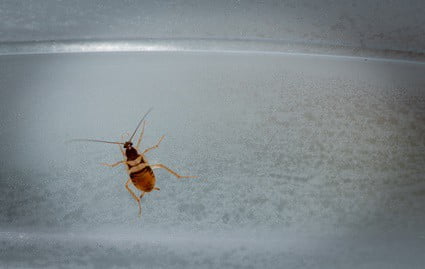
Can Roaches Survive In The Refrigerator?
The chilly temperatures of your fridge won’t kill cockroaches. Some species can survive the temperatures of Antarctica. So, the environment of your refrigerator is nothing in comparison.
According to Sanitary Animals, cockroaches can survive long-term in a fridge. Researchers determined that cockroach larvae could survive for up to 60 days in temperatures at 68 degrees Fahrenheit. Even if you remove any live adults, the egg sacs left behind may adversely affect the fridge.
Worse still, cockroaches are likely to find a heat source. This can be used to warm up their bodies, so they can continue to hide, eat, breed, and defecate.
Refrigerators generate more heat than the average appliance. Cockroaches will stay close to motors and other heat-generating components inside. The ambient heat is more than enough to keep cockroaches alive.
Are Roaches Warm Or Cold Blooded?
Cockroaches are ectotherms (unable to create their own body heat), so they draw heat from their environments. If they’re in a cold climate, they’ll seek out heat sources to compensate.
If the cockroaches in your fridge cannot find one, they’ll still survive by entering a phase called diapause. This slows down their metabolism and reduces their movements, so they don’t burn energy unnecessarily.
In this phase, cockroaches will be slow, lethargic, and unable to breed. In fact, they’ll stop producing the hormone necessary for mating. They’ll even stop growing if they’re a nymph and remain their current size. If they don’t escape the cold temperatures for several weeks, they may remain in this state without negative consequences.
Are Cockroaches Afraid Of Cold?
If cockroaches avoid your fridge, it’s because they can’t gain access or there are easier food stores nearby. Cockroaches may dislike the cold, but they aren’t repelled by it.
According to the Journal of Experimental Biology, all species prefer warmer environments because they function best in these conditions. It was determined that American cockroaches and German cockroaches thrive in temperatures of up to 91 degrees Fahrenheit. Oriental cockroaches prefer temperatures of up to 84 degrees Fahrenheit.
This temperature range allows cockroaches to be active, breed, and locate food sources. Because of this, cockroaches will always seek out the warm spots of your fridge if they can locate them. If they can’t, that won’t stop them from exploring the food sources.
The cold temperatures will discourage cockroaches from living inside the refrigerator long-term. However, if there’s a clear way in and out, the cold temperatures won’t prevent them from returning.
How To Remove Roaches From A Refrigerator
You may be unable to find the entry point, especially if it’s wrapped up in the components behind or underneath your fridge. Likewise, you may be searching for nymphs or egg sacs without much success.
No matter the case, there are steps you can take to remove cockroaches from your fridge. It will take patience and a careful hand so that you don’t make the appliance unsafe for your food.
Avoid placing insecticides inside the fridge. The leftover residue may linger even after you’ve cleaned it. This may contaminate your food with toxins that are more harmful than the cockroaches themselves.
Apply Insecticidal Dust Daily
Put insecticidal dust all around the fridge, cleaning and replacing the powder daily. When this powder comes into contact with a cockroach, it will gradually wear away the exoskeleton. Eventually, it will attack the nervous system or deteriorate the cockroach’s ability to absorb water over the next two weeks.
Cockroach Baits
Baits are mixed with scents that attract cockroaches so that they want to eat the bait. Once they do, the pesticide formula slowly kills them. Place these throughout your kitchen, with some behind and at the base of the fridge.
Home Remedies For Cockroaches In Fridge
If you must use pesticides, opt for home remedies. These are less toxic than traditional pesticides but are still harmful to cockroaches. Options include:
Sugar And Borax
Borax is a common household cleaning product. Borax can kill cockroaches by drying out their exoskeleton. Once their shell is compromised, borax works into the exoskeleton, slowly killing it.
If you can’t find borax, boric acid and baking soda are viable alternatives. Mix borax, boric acid, or baking soda with sugar in a 3:1 ratio. You can then spread it in areas where you notice cockroaches.
Essential Oils
According to the Southeast Asian Journal of Tropical Medicine and Public Health, essential oils are effective against cockroaches. Researchers have determined that kaffir essential oil has 100% efficiency under laboratory conditions.
To use kaffir oil as a cockroach repellent, mix 10 drops of essential oil in 2 cups of water. Use this mixture to wipe down surfaces that cockroaches frequent. You can also put this mixture in a spray bottle and spray as you go.
Crushed Cucumber
According to The Ohio Journal of Science, crushed cucumbers can repel up to 90% of cockroaches. Researchers determined that there are compounds present inside cucumbers that cockroaches dislike. Crushing the cucumber releases these compounds.
To use cucumbers as a pest repellent, chop them into small pieces and crush them finely. Place the cucumbers inside an aluminum can before putting them inside your fridge.
How To Get Rid Of Roaches In Fridge Motor
A common area for cockroaches to infest is the fridge’s motor. Be careful with any insecticides you use here. If you damage the motor while targeting the cockroaches, your entire refrigerator may need to be replaced.
Use Non-Liquid Pesticides
Any liquid pesticides may short out the motor and damage its coils. Because of this, use non-liquid formulations, such as dusts, baits, and traps.
If you must use liquid pesticides, place these behind or under the fridge. As the cockroaches exit on their way back to their colony, they’re likely to walk through the poison.
Glue Traps
Glue traps are made of a layer of glue mounted atop a sturdy piece of cardboard. When cockroaches step on the glue, they stick to the trap. This doesn’t instantly kill cockroaches but holds them firm so you can dispose of them. This allows you to capture any cockroaches near the motor without damaging the part itself.
You can also use this outside of the fridge or in areas throughout it. It enables you to see where cockroaches frequent and how many cockroaches are in the area. When paired with insecticides, it can enable you to determine where your bait should be placed.
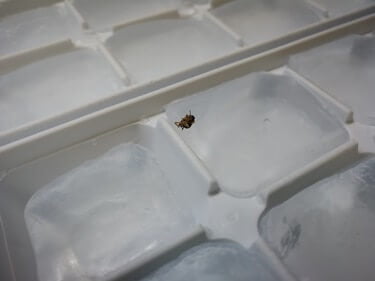
How To Remove Roaches In Deep Freezer
Cockroaches like to hide underneath deep freezers. This space is warmer, making it an attractive hiding place. Follow these steps:
Inspect And Identify
Deep freezers are colder than regular refrigerators. Some species, such as tropical cockroaches, cannot live in these conditions, but they’re unlikely to infest your home anyway. More resilient species can still lay eggs in colder conditions. That is why it is important to determine the type of cockroach type.
Use Pesticides Around The Freezer
Cockroaches will still exit the freezer, regardless of their species. Any pesticides used to deal with cockroaches inside a fridge can work just as well for a freezer. These include glue traps, insecticidal dust, and cockroach baits.
Clean Out The Underside
For cockroaches living outside of the freezer, remove them by destroying the nest beneath them. Any egg sacs, skins, or poop should be cleaned up. After that, place traps around the area so they can’t return.
How To Clean Cockroaches From Fridge
Cockroaches have the ability to contaminate your food. They leave behind mold spores, bacteria, and other contagents that are detrimental to your health. Because of this, you may need to consider getting rid of all food in your fridge. That’s especially true for anything that’s not tightly sealed in a container.
However, just because your fridge has been infested doesn’t mean the appliance is completely useless now. Use these steps to make the fridge safe again:
Remove All Food And Compartments
While contending with a cockroach problem, empty your fridge. This will keep the cockroaches from spreading bacteria onto the containers, wrappers, or the food itself.
All food containers should be sanitized and placed in a different fridge. You can freeze any food during this time. If you don’t have another option, tightly seal any food in containers and place it in a sealed area of the fridge. Also, separations and compartments that can be removed should be dismantled and cleaned.
Scrape Off Cockroach Eggs
Other than the cockroaches, any eggs should be removed. They’re usually well-hidden.
Clean With Food-Safe Cleaner
After removing cockroaches and their eggs, sanitize the inside of your fridge. If you’re using a commercial cleaner, ensure that it doesn’t have a strong scent and food grade.
Soak the compartments that you’ve removed in this solution. Then, clean the inside of your fridge with this mixture. Pay close attention to the handles, top, and bottom of your fridge.
Clean Area Around Fridge
Clean out the clutter and other objects that could attract cockroaches. Apply insecticidal dust to this area.
Cockroaches can get into your fridge through gaps in the door or the outer shell, but you can remove them. Of course, if your fridge is starting to show signs of decline, it may be the right time to replace it. However, if cockroaches have just found a way into your fridge because you left the door open, they can be safely removed.
